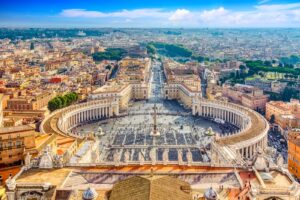Imagine that the fine arts suffer the effects of a catastrophe. A generation consumed with rebellious passions comes to regard the works of their predecessors with varying forms of antagonism, ranging from outright hostility to an ironic suspicion of their obsolescence.
Accordingly, the workers in each respective discipline endeavor to begin their craft all over again—to make it new, as it were—by rejecting every single standard or norm of artistic creation that has obtained in all of Western history.
Painters and sculptors discover new methods to mutilate and distort the body in their representations. Not long after this, they reject the notion of representation altogether, smearing paint haphazardly over a canvas and erecting junk on a pedestal.
Authors write as if the purpose of fiction is to conceal the plot as far as possible from the reader, by eschewing coherent narrative and consecutive thought, and poets in particular disclaim the entire range of formal techniques developed by their forebears, such as genre, meter, and public symbolism.
Start your day with Public Discourse
Sign up and get our daily essays sent straight to your inbox.Architects preach that any attempt to render an edifice proportional and appealing is too much “ornament,” a dishonest abuse of their craft. Instead, they erect whole metropolises filled with incongruous monstrosities, constructed out of the most sterile, repulsive materials imaginable, and devoid of a single lintel or column that might reveal an impulse to please on the part of the maker.
Meanwhile, some contemporaries of these artistic anarchists suddenly realize the great financial prospects for using emergent technologies to flood the general public with large quantities of typically mindless ephemera. Entertainment replaces art, and profit, not beauty, becomes the end of creation.
This sort of work is another revolt against the past, though one motivated by a love of lucre rather than ideology; the canon of standards derived from the masterpieces of the past has as little to do with these productions as with those described above.
Eventually, the two forms of artistic aberrancy merge into one, as subsequent generations discover they can pick the pockets of an entirely cowed public by affronting them with ever greater weirdness and vulgarity. Thousands and thousands of dollars are made by “artists” hacking up animal parts or canning effluvia; by writers composing thousand-page novels without a hint of plot, or thinly-veiled autobiographies recounting all the salacious details of growing up in various minority communities; by architects erecting lopsided buildings intended to nauseate visitors; by musicians who can barely play three chords on a guitar while assailing their audiences with varying modes of indecency.
As time passes, an increasingly stupefied public, having long since wearied of resisting this decadent trajectory, convinces itself that such detritus fully deserves the status of art, or rather, convinces itself that any question of desert in this matter is entirely meaningless.
“Who is to say what is art and what is not?” is their favorite critical nostrum. New canons are instituted, new standards decreed, locating exclusive merit in the qualities of novelty and offensiveness, and persons who have never so much as heard of Palestrina or Hölderlin in all their life assert, with perfect self-assurance, the excellence of cultural artifacts unrivaled for both their quantity and their worthlessness.
Readers familiar with After Virtue, Alasdair MacIntyre’s great work of moral philosophy, may recognize my attempt to mimic the opening paragraphs of that book. In order to comprehend what he takes to be the disastrous condition of moral discourse in our age, MacIntyre invites the reader to imagine a scenario in which scientific learning is destroyed through large-scale social upheaval, and then pieced together in a manner that is finally incoherent and futile.
Yet whereas MacIntyre found analogy necessary to show his readers the ruinous state of our ethical thought, in my case, desiring to convince the reader of the catastrophic condition of the arts, I find no need to resort to anything but a perfectly literal, even bald, description of the state of affairs, which, if it errs at all, errs on the side of understatement. For if our moral discourse presently betrays a severe disorder, the condition of our arts is infinitely more deplorable.
According to MacIntyre, the incoherence of modern ethical thought comes from shattering an ancient metaphysical picture, rooted in the work of Aristotle and attaining its most comprehensive elucidation in Aquinas.
It is a metaphysics of formal and final causes, a context that allows moral injunctions to be derived from the work of transforming “man-as-he-happens-to-be” (formal cause) into “man-as-he-could-be-if-he-realized-his-essential-nature” (final cause). It was “the elimination of any notion of essential human nature and with it the abandonment of any notion of a telos,” says MacIntyre, that represented the key conceptual misstep, which sent ethical philosophy hurtling down into the darkness of our age.
Yet it is not difficult to see how the destruction of this metaphysical picture was likely to have drastic consequences for coherent thinking about art-making too. For once man has been deprived of “any notion of essential human nature,” the creation of artifacts of a certain kind was bound to lose its status as an essential activity of human beings. Once it became common to doubt or to deny that man had any essential inclination toward beauty or truth, the purpose of making objects intended to unite beauty and truth in various ways was no longer evident.
More importantly, the dissolution of the Aristotelian picture robbed us of the way to properly understand a work of art, for it undermined the whole concept of a form. Any legitimate concept of artistic form obviously presupposes that same ancient metaphysics, for an artistic form is just that elegy-, or sonata-, or sculpture-as-it-could-be-if-it-realized-its-essential-nature, which is formed from the raw materials of words-, or notes-, or stones-as-they-happen-to-be.
From time immemorial, some notion of form, some idea of what sort of thing the artist is making when he is making, has governed the production of art. This concept indicates to the artist not only what sort of object he should create, but also, by implication, what sort of object he must not create. An artist like Donatello sculpted with some idea in mind that guided his hand toward the depiction of a certain stance or a certain facial expression, while simultaneously guiding his hand away from piling junk in an “installment” or welding together some amorphous blob.
Like those conceptions of human nature that condition all coherent ethical thought for MacIntyre, the forms of art are never derived from some sphere of “pure rationality,” but emerge out of the practices and social habits of particular societies, and develop within those societies’ artistic traditions.
One facet of such traditions has always been an accumulation of rules or precepts intended to guide artists toward the better perfection of their craft. Such rules, which now seem entirely antiquated, made perfect sense, and were indeed inevitable, so long as the concept of form retained its legitimacy, for then a rule of art was just a deduction of practical reasoning, which stated that if such and such feature of the work was dictated by its form, then such and such methods were the best way of attaining that feature.
Once the idea of form died off with common belief in an essential human nature, such rules were bound to appear arbitrary and confining. Just as in the sphere of ethics, the abandonment of the idea of essential nature led ineluctably to the abandonment of teleology. Thus the modern artist found himself in the same condition as the modern moralist: possessed of a horrible freedom, an ability to choose that was undetermined by any higher purpose than choice itself.
A work of art, like a well-lived life, could be whatever the artist decided he wanted it to be: a urinal, a plotless drama, a pastiche of random symbols, a great deal of screeching into a microphone, a large glass box. Beauty ceased to operate as any kind of aesthetic norm, because beauty, in the context of the work of art, just means the perfection of form. What we are looking at when we cast our eyes around at the enormous accumulation of trash polluting our cultural space so thoroughly and so depressingly is just the necessary effect of artistic labor proceeding after the abolition of the concept of form, and therefore, after beauty.
There is a history to be told about the decline of artistic form, analogous to MacIntyre’s history of the decline of virtue. It will include events within the arts themselves, like the rise of expressivist theories among the Romantics, which effectively placed the artist before artwork in order of importance, and the Modernists’ fundamental revolt against tradition, which severed them and their predecessors from the great storehouse of forms built up throughout the centuries.
This history will also include the vast social transformations that have pressured the arts from the outside, such as the democratization of education, the decline of artistic patronage and the increasing susceptibility of artists to market forces, and the advent of mass entertainment, with the technologies it requires.
As in MacIntyre’s work, there is also a story to be told about where we go from here, about how we can return to that ancient metaphysics, which, in the case of the arts, means a return to the idea of form. There is a story waiting to be told about how young artists can find the path forward out of our present cultural wasteland by meditating long and hard upon the forms in their respective disciplines, and striving for the technical virtuosity necessary to bring those forms to life again.
What these narratives would serve to clarify is that in our aesthetic discourse and practice, no less than in our moral, we have long since passed the point when the prevalent ideas have ceased to serve civilized life, and when it has become time to turn away from the habits of our age. What matters at this stage is the construction of vital new forms of artistic creation, and the institutions necessary to support their flourishing.
Young artists must return now to the masterworks of ages past with assiduous attention, striving to extract from them the secret of their excellence, so that they can achieve such excellence in our own time. We are waiting for a generation endowed with the capacity—seen several times before in our history—to transform a reverence for the past into the energy required for fundamental cultural renewal. We are waiting for new—and doubtless very different—Dantes, Giottos, and Brunelleschis.












